Philosophy of Education The Big Idea
Seeks to answer
What is taught?
What is the framework?
What is the purpose?
How is it taught?
Assessment isn't something that happens at the end of learning and stops there. Assessment begins during the planning stages with the KWL strategies to access prior knowledge (McMillan, 2014.). Assessment then moves forward to a formative format where it is a tool used to inform and enhance the learning. When proceeding to a summative format of assessment, self assessments are included to send the learner on a reflective journey and keep them honest about their learning (Castellon, 2017.). Portfolios of learning are developed and the teacher gives a final summative report of learning to inform the learner for the next time they continue their learning journey.
Co creating criteria is a necessary component to all parts of the design process. This is a large part of the planning stage to determine what is expected of students. This also informs a component of the instructional process and is a necessary component to the final stages of assessment. By co-creating criteria, the educator is directly involving the learner in their learning.
Forward Mapping
“Begins at the top of the process, with as clear a statement
as possible… and proceeds through a sequence of
increasingly more specific steps to define what is expected … at each level” (Hayes, 2003). Backward Mapping
Starts with the learning goals. Central question: “What do we want students to be able to know, value, understand and do?” (Hayes, 2003) Learning goals:
Knowledge of facts, concepts and methods
Depth of knowledge and understanding
High order thinking
The planning stage requires thinking about what the educator wants students to know. This is called backward mapping. (Hayes, 2003.) Then, educators look at what our students already know and can begin to develop the environment of our classroom for our learners (Shepherd, 2000.). By designing an experientially relevant and culturally relevant classroom, the planning stage will ensure that our learners will be able to have a comprehensive learning experience.
Teachers develop a problem design template leaving space to 1) Identify the problem, 2) Intended learning outcomes, 3) Background knowledge needed and 4) Potential solutions
Teachers develop a Learning Activity Template that state to 1) Learning objective 2) Instructional strategy 3) Resources needed 4) Assessment method.
Teachers develop a series of Rubric and Checklists that provide clear criteria of what is expected in terms of learning outcomes and problem solving process.
(Shepard, 2000) emphasizes the importance of aligning the assessments with the goals of problem based learning
Teachers use self assessment, peer assessment and teacher feedback to support student learning by providing feedback to identify weakness and strengths and areas of improvement.
(Hayes, 2003) suggest using rubrics, feedback and student reflection to evaluate how well the students work together communicate ideas and problem solve as a team.
Developmental Idea
The instruction begins with a focus on the informative planning stage. Creating a picture of what is expected of students is important for them to become invested in their learning and fosters self-efficacy. (Coumont-Golanowski, n.d.) This is also promoted through choice in project and scaffolding through ongoing checks for understanding to inform the learner of where they are at. (Hayes, 2003.) This will also help the learner to connect to the assessment stage of learning.
(McMillan, 2014) emphasized the importance of aligning instruction with the goal of problem based learning
Teachers begin by identifying real world problems or scenarios to engage students in critical thinking and problem solving.
(Hayes, 2003) emphasized that Students should work in groups, to research potential solutions and develop a presentation to share findings to promote engagement
Academic Idea
Socialization
Philosophy of Curriculum Design
Contemporary Orientation
Self Actualization Conception
Social Re-constructionism Conception
Learner Centered Designs
Child Centered
Experience Centered/Organic
Radical
Humanistic/Developmental
Problem Centered Designs
Life Situations
Reconstructionist
Social Function & Activity
Traditional Orientation
Cognitive Process Conception
Academic Rationalism Conception
Curriculum as Technology Conception
Subject Centered Designs
Subject Design/Subject Matter Design
Discipline Design/Interdisciplinary Integration
Broad Field/Broad Field
Correlation/Correlated Subjects
Process/Thematic
Essentialism Philosophy
Perennialism Philosophy
Progressivism Philosophy
Reconstructionism Philosophy
Pragmatism
Realism
Idealism
Characteristics of Traditional Orientations
Fixed & Absolute
Homogenous
Teacher Led
Competitive
Conservative
Conforming
Discipline
Cognitive
Subject Focused
3 R's
Characteristics of Contemporary Orientations
Subjective & Relative
Problem Solving
All subjects have value
Heterogenous
Correlative
Inquiry Based
Innovative
Liberal
Creative
Student centric
Other
Technology as a Curriculum
School to Work
Core
Similar thoughts on Dimension's and Organization
Scope
Sequence
Continuity
Integration
Planning
Forward Mapping
Backward Mapping
Learning Goals
Instruction
Classical Approach
Interactive Instruction
Assessment
Pre-assessment
Formative Assessment
Summative Assessment
Instruction
Identify the Problem
Research the Problem
Work Collabortively
Identify potential solutions
Design Presentation
Planning
Provide Learning Objective
Provide Instructional strategies
Provide Course Resources
Provide Assessment method
Assessment
Rubric
Checklist
Portfolios
Feedback
Identify areas for improvement
Adjust to support learning
Assessment
Ongoing Formative Assessment
Self-Assessment
Portfolios of Learning
Planning
Backward Mapping
Accessing Previous Knowledge
Getting to Know the Environment of Learners
Designing an Experientially Relevant Classroom
Ensuring the Instruction is Culturally Responsive
Instruction
Accessing Previous Knowledge
Choice in Project
Understanding the End Goal of Learning
KWL Strategies
Scaffolding and Ongoing Checks for Understanding
Classical approach: instruction is separated from assessment.
"Assessment and instruction are often conceived as curiously separate in both time and purpose" (Graue, 1993, as cited in Shepard, 2000) Interactive Instruction
Synchronized with Formative Assessment (McMillan, 2014)
Pre-Assessment
“Preassessment is what you will
do before instruction to ascertain students' knowledge, attitudes, and interests” (McMillan, 2014).
including examining scores on previous tests
testing knowledge of facts, concepts and methods from prerequisite courses
Assessment strategies include:
Assessment of Prior Knowledge
Explicit Criteria
Formative Assessment
“Formative assessment information is used to monitor learning, check for progress, diagnose learning problems, and specify instructional adjustments” (McMillan, 2014).
Assessment strategies include:
Dynamic Assessment
Dynamic Feedback
Evaluation of Teaching
Summative Assessment
“Summative assessment is conducted after instruction
primarily as a way to document what students know, understand, and can do” (McMillan, 2014).
Assessment strategies include:
Summative feedback
Students’ self-assessment
